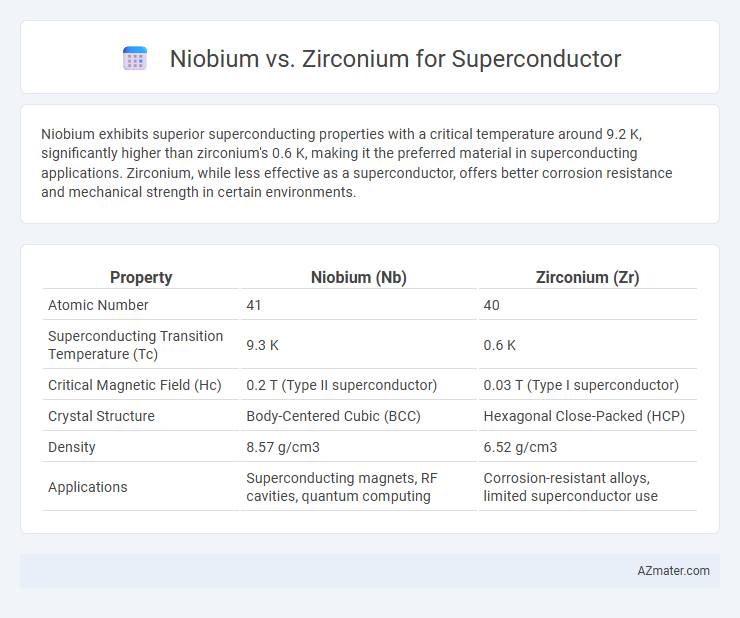Niobium exhibits superior superconducting properties with a critical temperature around 9.2 K, significantly higher than zirconium's 0.6 K, making it the preferred material in superconducting applications. Zirconium, while less effective as a superconductor, offers better corrosion resistance and mechanical strength in certain environments.
Table of Comparison
| Property | Niobium (Nb) | Zirconium (Zr) |
|---|---|---|
| Atomic Number | 41 | 40 |
| Superconducting Transition Temperature (Tc) | 9.3 K | 0.6 K |
| Critical Magnetic Field (Hc) | 0.2 T (Type II superconductor) | 0.03 T (Type I superconductor) |
| Crystal Structure | Body-Centered Cubic (BCC) | Hexagonal Close-Packed (HCP) |
| Density | 8.57 g/cm3 | 6.52 g/cm3 |
| Applications | Superconducting magnets, RF cavities, quantum computing | Corrosion-resistant alloys, limited superconductor use |
Introduction to Superconductors: Niobium and Zirconium
Niobium is widely recognized as the preferred element for superconducting applications due to its high critical temperature and magnetic field tolerance, making it essential in superconducting magnets and MRI machines. Zirconium, while less common in pure form for superconductors, is often used as an alloying element to enhance the mechanical properties and corrosion resistance of niobium-based superconducting materials. The combination of niobium's superior superconducting properties with zirconium's structural benefits optimizes performance in advanced superconducting systems.
Atomic Structure and Elemental Properties
Niobium exhibits a body-centered cubic (BCC) atomic structure with a high critical temperature (Tc) of 9.3 K, making it the most widely used element in superconducting applications due to its strong electron-phonon coupling and high critical magnetic field. Zirconium, with a hexagonal close-packed (HCP) structure at room temperature and a lower Tc around 0.6 K, offers lower strength but superior corrosion resistance and ductility, which are advantageous in specific superconducting alloys. The elemental properties of niobium, including its larger atomic radius and electron configuration [Kr] 4d4 5s1, contribute to more robust superconducting characteristics compared to zirconium's [Kr] 4d2 5s2 configuration and atomic packing.
Superconducting Critical Temperature Comparison
Niobium exhibits a higher superconducting critical temperature (Tc) of approximately 9.2 K compared to zirconium's Tc, which is around 0.6 K. This significant difference makes niobium more favorable for applications requiring higher temperature superconductivity in superconducting magnets and RF cavities. The distinct electronic structures and alloying behaviors contribute to niobium's superior superconducting critical temperature performance over zirconium.
Electrical Conductivity and Resistance Characteristics
Niobium exhibits superior electrical conductivity and lower electrical resistance compared to zirconium, making it the preferred material for superconducting applications. Niobium-based superconductors, such as NbTi and Nb3Sn, demonstrate critical temperatures around 9.2 K and 18 K respectively, outperforming zirconium alloys which have limited superconducting properties. The enhanced electron scattering resistance and higher critical magnetic fields in niobium contribute to its efficiency in magnetic resonance imaging (MRI) and particle accelerator technologies.
Magnetic Field Performance: Niobium vs Zirconium
Niobium exhibits superior magnetic field performance compared to zirconium, with a higher critical magnetic field (Hc) reaching up to 0.4 Tesla for pure Nb, making it highly effective in superconducting magnets used in MRI and particle accelerators. Zirconium, while showing some superconductivity, has a significantly lower critical field, typically below 0.1 Tesla, limiting its application in high-field superconducting environments. The intrinsic properties of niobium, including its critical temperature of 9.3 K and strong flux pinning capabilities, enhance its performance under intense magnetic fields.
Mechanical Strength and Durability
Niobium exhibits superior mechanical strength and durability compared to zirconium, making it the preferred choice in high-performance superconductors. Its enhanced tensile strength and resistance to deformation ensure stability under extreme operational stresses, while zirconium, though corrosion-resistant, lacks comparable mechanical robustness. This distinction is critical for maintaining structural integrity and prolonging the lifespan of superconducting components in demanding environments.
Corrosion Resistance and Environmental Stability
Niobium exhibits superior corrosion resistance and environmental stability compared to zirconium, making it the preferred material in superconducting applications where long-term performance and resistance to oxidation are critical. Zirconium's corrosion resistance is moderate but can degrade under harsh environmental conditions, limiting its use in superconducting systems exposed to reactive atmospheres. Niobium's stable oxide layer and robust mechanical properties contribute significantly to its reliability and durability in advanced superconducting technologies.
Industrial Applications in Superconductor Technologies
Niobium exhibits superior superconducting properties with a critical temperature around 9.3 K, making it the key material in industrial superconductors such as Nb-Ti and Nb3Sn wires used in MRI machines and particle accelerators. Zirconium, while less common, offers enhanced corrosion resistance and mechanical strength, making it valuable for niche superconducting applications requiring robustness in harsh environments. Industrial superconductor technologies prioritize niobium alloys for their higher critical current densities and magnetic field thresholds, crucial for efficient energy transmission and high-performance electromagnets.
Cost, Availability, and Fabrication Challenges
Niobium remains the primary choice for superconductors due to its relatively abundant availability and lower overall cost compared to zirconium, which is scarcer and more expensive. Fabrication of niobium-based superconductors benefits from established industrial processes, whereas zirconium presents challenges like higher contamination risk and difficulty achieving the necessary purity levels. The cost-effectiveness and mature manufacturing techniques make niobium significantly more viable for large-scale superconductor applications despite zirconium's potential material advantages.
Future Trends and Research Directions
Research on niobium-based superconductors focuses on enhancing critical temperature and magnetic field resilience, with Nb3Sn and NbTi remaining pivotal in practical applications like MRI and particle accelerators. Zirconium alloys, though less common, are gaining attention for their potential to improve flux pinning and mechanical properties in composite superconducting materials. Future trends emphasize nanostructuring and doping strategies in niobium and zirconium compounds to optimize superconducting performance and enable next-generation quantum computing and energy transmission technologies.

Infographic: Niobium vs Zirconium for Superconductor
 azmater.com
azmater.com